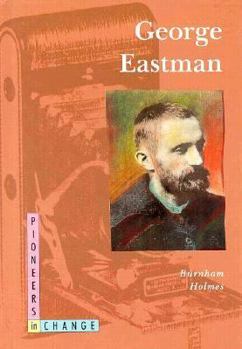George Eastman
Select Format
Select Condition 
Book Overview
Describes the life of the man who revolutionized photography by developing a camera simple enough for anyone to use. This description may be from another edition of this product.
Format:Hardcover
Language:English
ISBN:0382241703
ISBN13:9780382241703
Release Date:January 1992
Publisher:Silver Burdett Press
Length:138 Pages
Weight:1.60 lbs.
Dimensions:0.6" x 6.4" x 9.3"
Age Range:9 to 12 years
Grade Range:Grades 4 to 7
Customer Reviews
1 rating
The Man and His Institution
Published by Thriftbooks.com User , 18 years ago
George Eastman, by Burnham Holmes In earlier days a photograph was a rare experience (Chapter 1). George Eastman was born in 1854. His father ran a business school in Rochester (double-entry bookkeeping), but died young. His mother took in lodgers, and George went to work at 14. He changed jobs to make more money and did well. At 23 he started to learn photography and became interested in the practical side of this business (Chapter 2). The camera obscura was around for centuries and used to trace objects; modern chemical photography dates to the early 19th century. The daguerreotype was the first successful method of photography. William Talbot created the first negative-positive process, which allowed copies. Frederick Archer invented collodion plates for faster exposures (Chapter 3). Eastman's experiments in simplifying photography led to his invention of dry plates, then a machine for making dry plates. Eastman got patents on this. His business became so successful he quit his bank job. Next he invented a flexible film to replace fragile glass (Chapter 4). Chapter 5 tells how Eastman developed celluloid films and a lower-priced camera that would bring photography to the masses. Eastman Kodak became one of the famous companies of the 20th century. The snapshots of amateur photographers preserved family memories. Chapter 6 has a brief history of the Eastman Kodak company. The development of motion pictures is summarized in Chapter 7. The book tells of other advances in photography: color films, aerial photography, cellulose acetate for fabric-covered airplane wings, and camouflage for ships at sea (Chapter 8). Eastman opened dental clinics for children in Rochester and other cities. He was a benefactor to MIT, Tuskegee University, and Hampton University. He also helped establish the medical complex at the University of Rochester, and a College for Women. He used his money for the common good (Chapter 9). Eastman was interested in music and started a School of Music and the Rochester Symphony Orchestra (Chapter 10). All around Rochester are buildings that are memorials to George Eastman. It became the photographic capital of the world. Eastman believed that people should earn their money, not inherit it (he never married and was childless). His fear of an illness that would affect his mind caused his death at home (Chapter 12). This 1992 book does not cover the later years of his company. There were missteps along the way. Their 8 mm film had a smaller negative area than the same width 9.5 mm film used in Europe. The "126" cartridge did not have a flat film plane. The rising price of silver and oil drove up costs in the 1970s. The introduction of "110" film was a mistake. Other competitors were on the rise, along with new technology like videotapes, compact disks, and digital cameras which reduced the sales of their film , processing, and paper. These slips affected its business. If mistakes can't be corrected a vicious circle follows.






